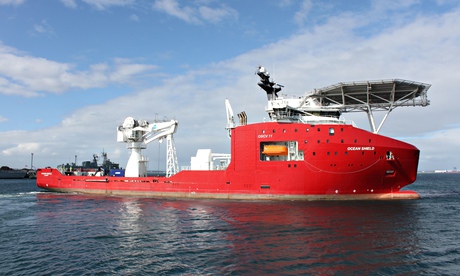Search for Malaysia Airlines flight MH370 moves further south
Investigators trying to solve the mystery of the jet's disappearance are moving to a zone 1,000 miles west of Perth

One of the ships searching for Malaysia Airlines flight MH370. Photograph: David Le-May/BBC/David Le-May
The drawn-out search for Malaysia Airlines flight MH370 will revert to an area hundreds of miles south of the previously suspected crash site following new analysis of the plane's flight path, a report said on Friday.
Investigators grappling to solve the mystery of the jet's disappearance are set to scour a zone 1,100 miles (1,800km) west of Perth – previously subject to an aerial search – when an underwater probe resumes in August, the West Australian newspaper said.
Citing unnamed US sources, the newspaper said Australia's Joint Agency Coordination Centre (JACC) would soon announce that the hunt would move 500 miles south-west from where it was previously focused.
It said the sources had revealed that survey ship Fugro Equator was already operating in this area and would soon be joined by Chinese vessel Zhu Kezhen.
A massive aerial and underwater search for MH370, which had 239 people on board when it diverted from its Kuala Lumpur to Beijing flight path on 8 March, has failed to find any sign of the plane.
Scientists from British company Inmarsat told the BBC earlier this week that the search had yet to target the most likely crash site, or "hotspot", after becoming diverted by pings thought at the time to have originated from the plane's black boxes.
It was not clear from the West Australian report whether the new search area overlapped with the "hotspot".
JACC said on Friday that the revised search zone, based on an intensive study of satellite communications from the jet and other data, would be announced by the end of the month.
Australian officials have said repeatedly that the revised search zone would be in the area of the seventh arc, or the final satellite "handshake" from the plane, believed to be when the aircraft ran out of fuel and was in descent.
JACC said the Fugro Equator was now working in this zone.
"Located along the seventh arc, that area is consistent with provisional analysis of satellite and other data that is being used to determine the future search area," it said.
Australian officials announced earlier this week that a survey of the seabed, as yet mostly unmapped and crucial to the success of the underwater search, had resumed.
Two ships – Fugro Equator and Zhu Kezhen – will survey an area up to 6,000m deep and covering up to 60,000 sq km before a contractor begins an intensive undersea search looking for debris.
Previously an intensive undersea search for the plane, in the area in which the acoustic noises were detected, failed to find any sign of the jet. The source of the noises is unknown.
No comments:
Post a Comment
Thanks for commenting. Your comments are needed for helping to improve the discussion.